Purpose and Audience in Ancient Mediterranean Art
Grace Lewis
11 min read
Listen to this study note
Study Guide Overview
This study guide covers purpose and audience in ancient Mediterranean art, focusing on the Code of Hammurabi, Mortuary Temple of Hatshepsut, Tutankhamun's Tomb (including his innermost coffin and death mask), the Apadana at Persepolis, the Acropolis of Athens, the House of the Vettii, Head of a Roman Patrician, Forum of Trajan (including the Basilica Ulpia and Column of Trajan). It emphasizes understanding the historical context, intended audience, and function of each artwork. The guide also includes practice questions and exam tips.
#AP Art History: Purpose and Audience in Ancient Mediterranean Art 🏛️
Hey there, future art historian! Let's get you prepped for the exam with a super-focused review of how ancient Mediterranean art served its purpose and who it was made for. We'll break down each piece, making sure you're not just memorizing but understanding.
Remember, this unit is all about understanding the context behind the art. Think about who made it, why, and for whom. This is crucial for both multiple-choice and free-response questions.
# The Code of Hammurabi 📜
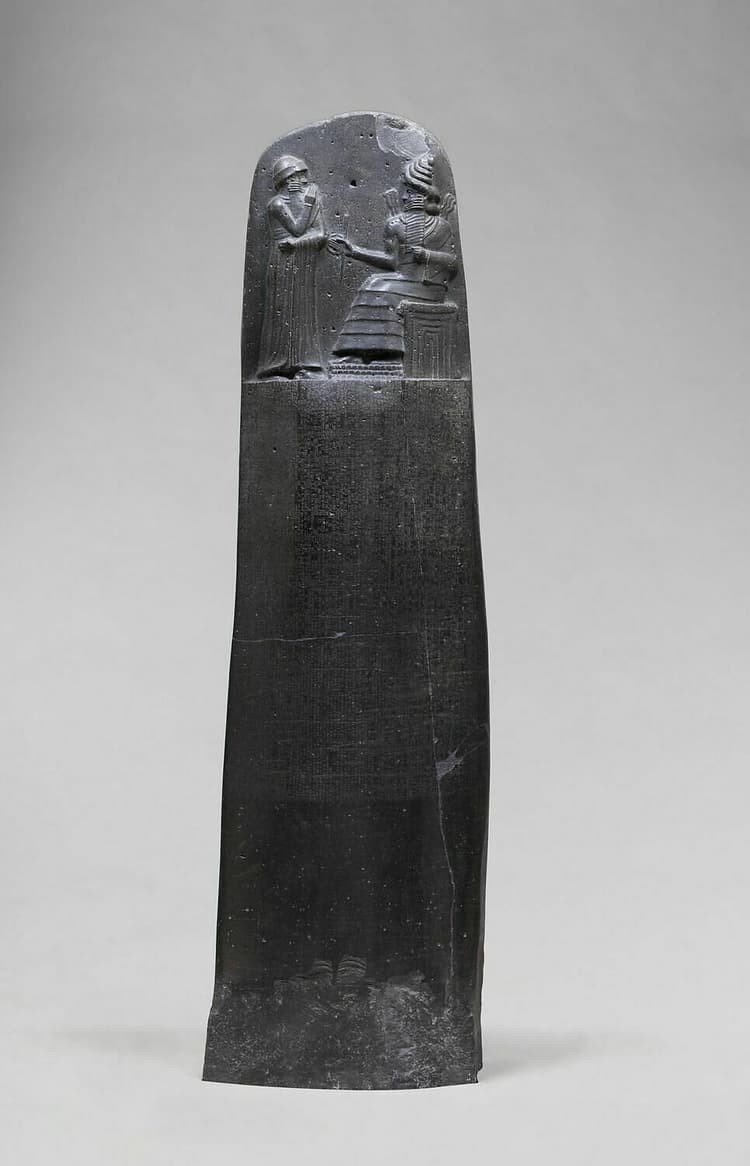
#Law Code Stele of King Hammurabi, basalt, Babylonian, 1792–50 B.C.E. (Musée du Louvre, Paris)
- What It Is: A massive basalt stele (stone slab) inscribed with one of the oldest known legal codes.
- Purpose: To establish and communicate the laws of Babylon under King Hammurabi.
- Audience: Intended for the public, especially those who needed to know the rules and consequences of breaking them. Also, to reinforce Hammurabi's authority as a just ruler.
- Key Features:
- 282 laws covering various aspects of life.
- The principle of "an eye for an eye" (lex talionis).
- Written in Akkadian using cuneiform script.
Think of the Code of Hammurabi as a public announcement of the king's power and the legal structure of his kingdom. It's not just a list of rules; it's a statement of authority.
# Mortuary Temple of Hatshepsut 👑

#Mortuary Temple and Large Kneeling Statue of Hatshepsut, c. 1479-58 B.C.E., New Kingdom, Egypt.
- What It Is: A grand temple complex dedicated to the female pharaoh Hatshepsut.
- Purpose: To honor Hatshepsut, commemorate her reign, and provide a place for her cult worship after her death.
- Audience: Intended for religious officials, the royal family, and the public, to witness her power and divinity.
- Key Features:
- Terraced architecture that blends into the landscape.
- Intricate carvings and reliefs depicting Hatshepsut's achievements.
- Located in the Valley of the Kings, on the west bank of the Nile.
Remember Hatshepsut's Holy Hills. The temple's terraced design blends into the landscape, making it a visually powerful statement of her reign.
# Tutankhamun's Tomb ⚱️
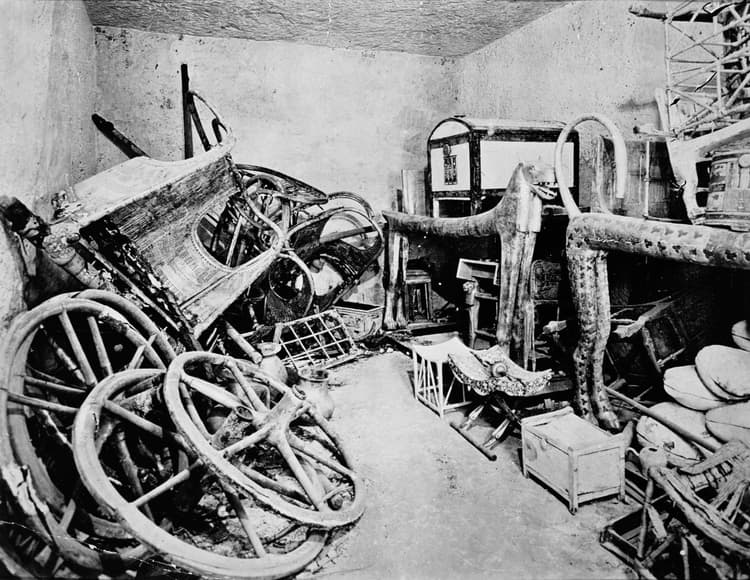
#Harry Burton, View of tomb interior, 1922 (Tutankhamun Archive, Griffith Institute, University of Oxford)
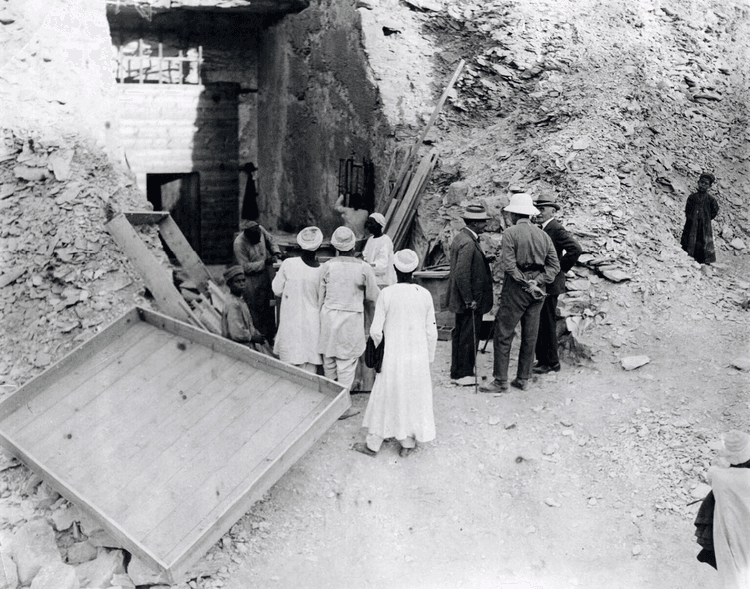
#George Edward Stanhope Molyneux Herbert, Fifth Earl of Carnarvon, with Howard Carter during his initial visit to the tomb, 1922, 7 5/8 x 9 5/8 inches (National Portrait Gallery, London; photo: Keystone Press Agency Ltd.)
- What It Is: The tomb of the young pharaoh Tutankhamun.
- Purpose: To provide everything Tutankhamun needed for the afterlife, ensuring his successful transition.
- Audience: Primarily intended for the deceased pharaoh, but also for the gods and spirits.
- Key Features:
- Discovered largely intact in 1922 by Howard Carter.
- Contains a wealth of artifacts, including the golden death mask and nested coffins.
- Filled with items for daily life and religious ceremonies.
# Innermost Coffin of Tutankhamun ⚰️

#Tutankhamun’s tomb, innermost coffin, New Kingdom, 18th Dynasty, c. 1323 B.C.E., gold with inlay of enamel and semiprecious stones (Egyptian Museum, Cairo)
- What It Is: The innermost of Tutankhamun's nested coffins.
- Purpose: To protect the mummy and ensure the pharaoh's safe journey to the afterlife.
- Audience: Primarily for the deceased pharaoh and the gods.
- Key Features:
- Made of solid gold with intricate inlays.
- Depicts the pharaoh with traditional symbols of power.
- Part of a series of nested coffins for maximum protection.
# Death Mask of Tutankhamun 🎭
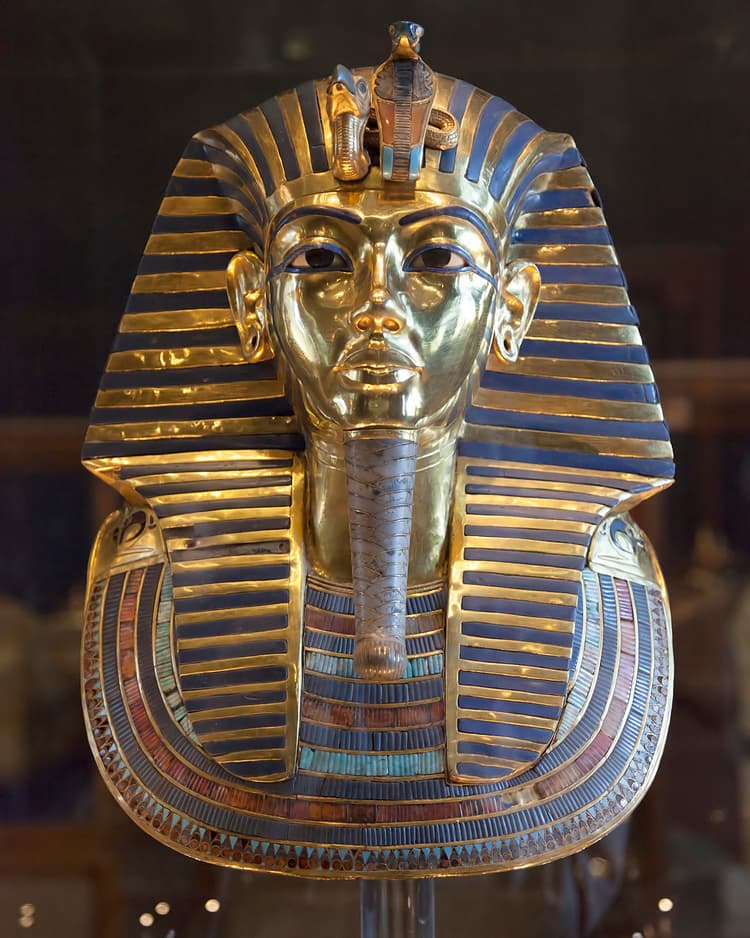
#Death Mask from innermost coffin, Tutankhamun’s tomb, New Kingdom, 18th Dynasty, c. 1323 B.C.E., gold with inlay of enamel and semiprecious stones (Egyptian Museum, Cairo) (photo: Roland Unger, CC BY-SA 3.0)
- What It Is: A golden mask that covered the mummy's face.
- Purpose: To protect the pharaoh's face and ensure his spirit could recognize his body in the afterlife.
- Audience: Primarily for the deceased pharaoh and the gods.
- Key Features:
- Made of solid gold with inlays of precious stones.
- Depicts the pharaoh with traditional symbols of power.
- Features the vulture and cobra symbols of Nekhbet and Wadjet.
The death mask of Tutankhamun is not just a beautiful object; it's a powerful symbol of royal authority and the belief in the afterlife.
# Audience Hall (Apadana) 🏛️
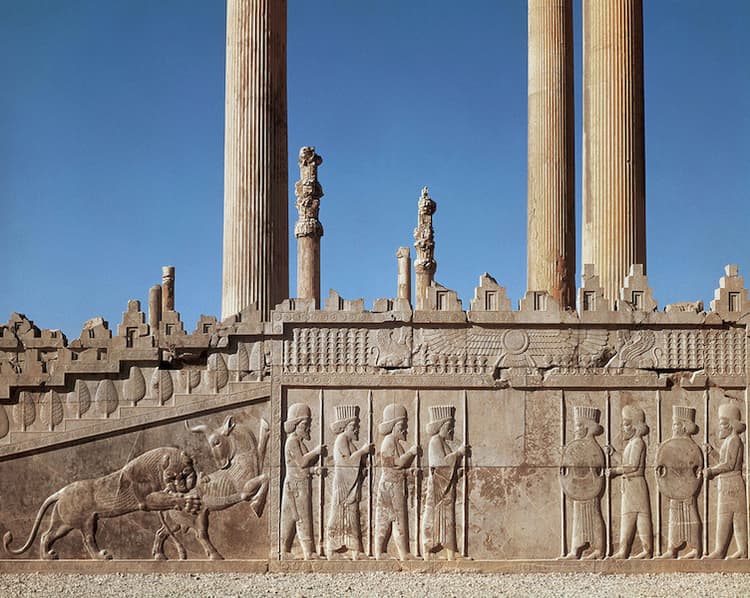
#East stairway, Apādana, Persepolis (Fars, Iran), c. 520–465 B.C.E.

#Apādana, Persepolis (Fars, Iran), c. 520–465 B.C.E. (photo: Alan Cordova, CC BY-NC-ND 2.0)
- What It Is: A large audience hall in the palace complex at Persepolis.
- Purpose: To host important state ceremonies and receive foreign dignitaries.
- Audience: Intended for the Persian elite, foreign ambassadors, and the general public during special occasions.
- Key Features:
- Massive scale with towering columns.
- Reliefs depicting Persian soldiers, officials, and tributary nations.
- Built by Darius the Great and completed by Xerxes I.
When discussing the Apadana, highlight its scale and the message of power and control it conveys. The reliefs are key to understanding its purpose.
# Acropolis of Athens 🏛️

#Iktinos and Kallikrates (Phidias directed the sculptural program), Parthenon, Athens, 447 - 432 B.C.E.
- What It Is: A fortified hilltop complex in Athens.
- Purpose: To serve as a religious, political, and cultural center for the city.
- Audience: Intended for the citizens of Athens, visitors, and the gods, particularly Athena.
- Key Features:
- Includes the Parthenon, Erechtheion, Propylaea, and Temple of Athena Nike.
- Built during the 5th century BC, a symbol of Athenian power and prestige.
- Dedicated to the goddess Athena.
# House of the Vettii 🏠

#View through atrium to the peristyle, photo: Peter Stewart (CC BY-NC 2.0)

#Fourth style wall paintings (from a room off the peristyle), House of the Vettii, Pompeii, photo: Lady Erin (CC BY-NC-ND 2.0)
#Myth of Pentheus Painting
- What It Is: A Roman villa in Pompeii.
- Purpose: To serve as a private residence for wealthy merchants, showcasing their status and taste.
- Audience: Intended for the Vettii family, their guests, and household members.
- Key Features:
- Well-preserved frescoes and mosaics.
- Peristyle courtyard, triclinium, lararium, and kitchen.
- Showcases Roman domestic life and mythology.
Don't confuse the House of the Vettii with public structures. It's a private home, reflecting the owners' wealth and social standing.
# Head of a Roman Patrician 🗿
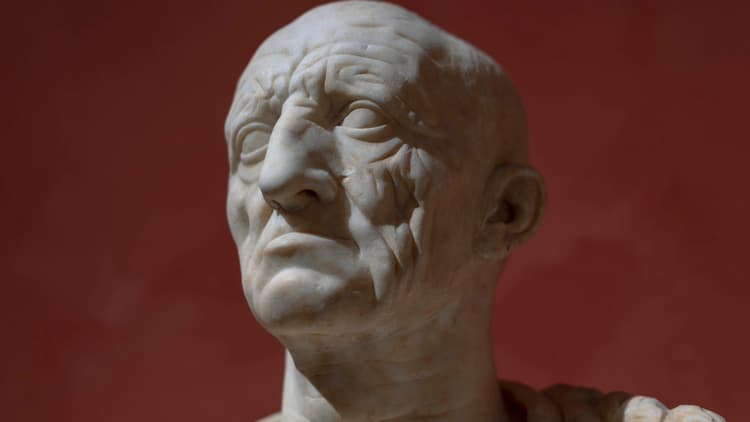
#Head of a Roman Patrician from Otricoli, c. 75–50 BCE, marble (Palazzo Torlonia, Rome, photo: Steven Zucker, CC BY-NC-SA 2.0)
- What It Is: A sculpted head of a Roman aristocrat.
- Purpose: To commemorate and represent the individual's status, character, and lineage.
- Audience: Intended for the public, family members, and future generations.
- Key Features:
- Realistic and detailed features.
- Example of Roman portraiture, emphasizing individuality.
- Made of marble.
Think of Roman portraiture as "warts and all." The realistic features aim to capture the individual's unique character and status.
# Forum of Trajan 🏛️

#Plan of the Forum of Trajan. Note that the traditional site of the temple of the deified Trajan is shown, but is replaced by a shrine located at the southern side of the forum’s main square (following R. Meneghini) (image: Slånbär, CC BY-SA 3.0, annotated by Smarthistory)
- What It Is: A large public square built by Emperor Trajan.
- Purpose: To serve as a civic center, celebrating Trajan's achievements and the glory of Rome.
- Audience: Intended for the citizens of Rome, visitors, and the Roman elite.
- Key Features:
- Includes a market, basilica, temple, and triumphal arch.
- Features the Column of Trajan, a visual record of his military campaigns.
- Located on the Quirinal Hill.
# Basilica Ulpia 🏛️
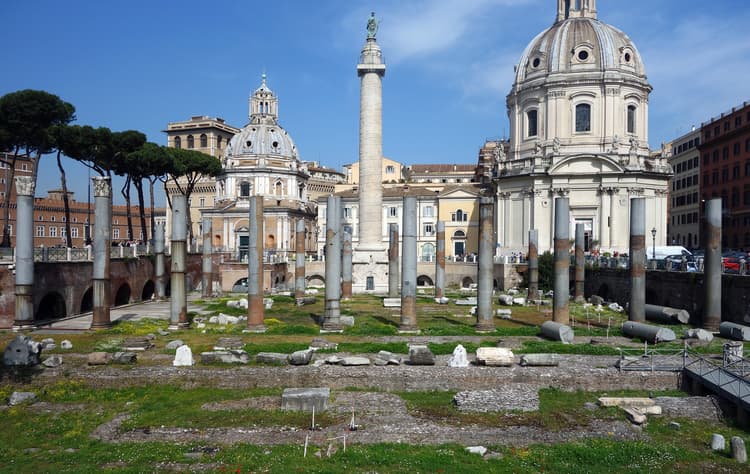
#Remains of the Basilica Ulpia in the foreground, and the Column of Trajan in the middle ground (photo: Steven Zucker, CC BY-NC-SA 2.0)
- What It Is: A monumental public building within the Forum of Trajan.
- Purpose: To serve as a civic center for law, commerce, and public gatherings.
- Audience: Intended for the citizens of Rome, legal officials, and merchants.
- Key Features:
- Grand columns, high central nave, and elaborate architectural details.
- Located in the Forum of Trajan.
- One of the largest basilicas in ancient Rome.
# Column of Trajan 🏛️
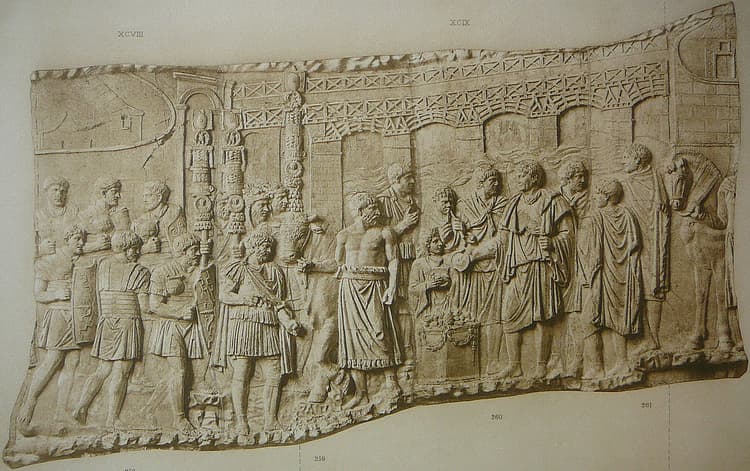
#Relief from the Column of Trajan, Carrara marble, completed 113 C.E., showing the bridge in the background and in the foreground Trajan is shown sacrificing by the Danube river (photo: Gun Powder Ma, public domain)
- What It Is: A monumental column commemorating Trajan's military victories.
- Purpose: To celebrate Trajan's military achievements and the power of the Roman Empire.
- Audience: Intended for the citizens of Rome, visitors, and future generations.
- Key Features:
- Spiral frieze depicting Trajan's campaigns in Dacia.
- Made of marble, standing at approximately 125 feet tall.
- A visual record of Roman military might and expansion.
The Forum of Trajan, Basilica Ulpia, and Column of Trajan are all interconnected. They work together to showcase the power and achievements of Emperor Trajan and the Roman Empire.
#Final Exam Focus 🎯
- High-Priority Topics:
- The role of art in conveying political power and religious beliefs.
- The relationship between art and its intended audience.
- The use of specific materials and techniques in different cultures.
- The impact of historical context on the meaning of art.
- Common Question Types:
- Multiple choice questions that test your knowledge of specific artworks and their purposes.
- Short answer questions that ask you to analyze the function of a work of art.
- Free-response questions that require you to compare and contrast different artworks and their cultural contexts.
- Last-Minute Tips:
- Time Management: Don't spend too long on any one question. If you're stuck, move on and come back later.
- Common Pitfalls: Avoid vague answers. Be specific and use the correct terminology.
- Strategies: When analyzing a work of art, always consider its purpose, audience, and historical context. Use the mnemonic P.A.H. (Purpose, Audience, History).
Remember to connect the artworks to their historical and cultural context. This will help you write more insightful and well-supported answers.
#
Practice Question
#Practice Questions 📝
Multiple Choice Questions
-
The primary function of the Code of Hammurabi was to: (A) Serve as a religious text (B) Establish a legal system (C) Document historical events (D) Celebrate military victories
-
The Mortuary Temple of Hatshepsut is best known for its: (A) Massive scale and intricate carvings (B) Use of concrete and arches (C) Lack of decoration and simplicity (D) Location in a residential area
-
The Column of Trajan serves primarily as a: (A) Religious monument (B) Commemorative sculpture (C) Public meeting place (D) Defensive structure
Free Response Question
Compare and contrast the purposes and audiences of the Mortuary Temple of Hatshepsut and the Forum of Trajan. How do these structures reflect the power and values of their respective cultures? (10 points)
Scoring Breakdown
- Introduction (1 point): Briefly introduce the Mortuary Temple of Hatshepsut and the Forum of Trajan, mentioning their respective cultures (Egypt and Rome).
- Mortuary Temple of Hatshepsut (3 points):
- Purpose: Funerary monument for Hatshepsut, place for cult worship, and commemoration of her reign.
- Audience: Religious officials, royal family, and the public.
- Reflection of Power and Values: Demonstrates Hatshepsut’s authority as a pharaoh and her divine status.
- Forum of Trajan (3 points):
- Purpose: Civic center, celebrating Trajan’s achievements, and a place for public gatherings.
- Audience: Citizens of Rome, visitors, and the Roman elite.
- Reflection of Power and Values: Showcases Roman military might, imperial expansion, and the emperor’s prestige.
- Comparison and Contrast (2 points):
- Similarities: Both are grand structures designed to convey power and commemorate leaders.
- Differences: The Mortuary Temple is primarily religious and funerary, while the Forum is civic and celebratory.
- Conclusion (1 point): Summarize the key differences and similarities in their purposes and audiences, highlighting how they reflect their respective cultures.
You've got this! Remember, it's all about understanding the context and the message behind the art. Now go ace that exam! 💪
Continue your learning journey

How are we doing?
Give us your feedback and let us know how we can improve





